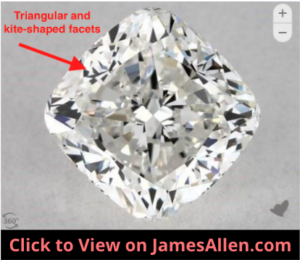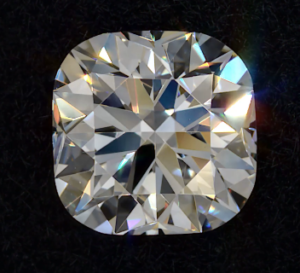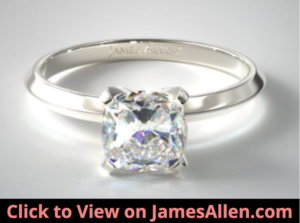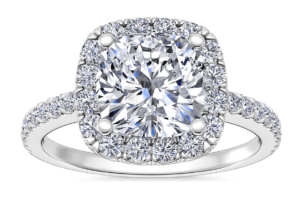
There are many diamond cuts that can serve as the center stone on an engagement ring or any other piece of jewelry.
Cushion cuts are a fancy shape that have gained popularity in recent years because of its vintage appeal, fire, and affordability compared to other cuts.
While you mistake it for a round cut at first glance, its outline and alignment of facets is slightly different than the classic design.
Let’s explore 12 pros and cons of cushion cut diamonds, so you’ll know if it’s right for you.
What are Cushion Cut Diamonds?
Cushion cut diamonds have a square shape with rounded corners. They mimic the shape of a pillow and often have 58 triangular or kite-shaped facets.
The cut was introduced more than 200 years ago and known as the “old mine cut.”
Check out the cushion cut below in high-resolution, where you can identify the individual facets on its table.
Until new technology helped diamond cutters produce a round brilliant cut, cushion cuts were the standard shape.
Today, they’re often the fourth most popular diamond cut for engagement rings, behind round, princess, and marquise cuts.
In addition to sitting on top of a ring as the main diamond, you’ll also find them lining the shank as diamond accents to add sparkle to the piece.
Pros of Cushion Cuts
Exhibit Strong Fire
The fire of a diamond refers to how it collects white light and disperses it into a rainbow of colors when it reflects off the facets.
This enhances its visual appeal and is a valued trait in a diamond.
The image below shows a cushion cut reflecting colored light, in addition to the white.
Fire is distinct from brilliance, which is flashes of white light.
Cushion cuts often display more fire than any other fancy shape diamond, even radiant cuts. It’s a result of its small table and large culet, which is the bottom tip of a diamond.
Light hits the physical facets on a cushion cut to create virtual ones.
Diamonds can refract more light when a higher number of virtual facets are present.
If you twirl a cushion cut around under light, you’ll notice both colored and white light reflecting from the surface of its facets.
To maximize the amount of fire in your cushion cut, choose one with excellent symmetry and polish. With smooth, well-cut facets, you minimize light leaking from the pavilion.
Price
Cushion cuts are less expensive than round brilliants and other fancy shapes. They sell for a lower price per carat for two reasons.
The first reason is there is less demand for cushion cuts compared to round, princess, and marquise cuts. Lower demand results in a price decrease.
The second reason is cushion cuts don’t require throwing out as much of the original rough diamond. The shape of a cushion cut is closer to the actual shape of a rough diamond, so there’s less waste.
Expect to save 30-45 percent on a cushion cut compared to a round cut with the same qualities and carat weight.
To provide a real example, I compiled prices for cushion and round cuts from James Allen, the online diamond store where I bought my wife’s engagement ring, with the following qualities:
- Carat: 1.00
- Color: G
- Clarity: VS2
The average price of a cushion cut with those qualities is $3,992, with a range of $2,960-$4,770.
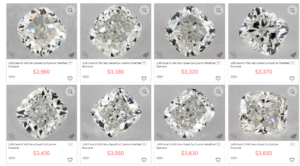
For a round cut, the average price is $6,337. The range is $5,340-$7,060.
That’s a savings of 41 percent for a round cut compared to a cushion cut.
The concept is true for cushion cuts compared to princess cuts. At James Allen, the average price for a cushion cut is 13 percent less than a princess cut of the same quality.
To save on the price per carat of your diamond, consider a cushion cut.
Variety of Shapes
Cushion cuts are available in more than one shape. Some have a higher length to width ratio than others, which means it can appear more rectangular compared to the classic square shape.
The three diamonds below are all cushion cuts, but notice they’re different shapes.

The one on the left has edges that more rounded than the other two, and it’s closer to a square.
The most popular cushion cuts have a length to width ratio of 1.10-1.20. They look like a rectangle to the naked eye.
On the other hand, any cushion cut between 1.00-1.05 will appear as a square.
The length to width ratio isn’t only about appearance. In fact, if you’re considering a square-shaped cushion cut, ensure its ratio is between 1.00-1.03.
Any higher can result in a poor cut, which reduces fire and brilliance.
For rectangular cushion cuts, choose a ratio between 1.10-1.30. You don’t want a cushion cut that’s stretched too thin.
Multiple Types of Cuts
There are multiple types of cushion cuts that each have different facet patterns and ways of interacting with light.
Old mine cushions are the original. Its geometric facets are more chunky than other variations. Developed in the 1700s, it’s known for its large culet, high crown, and deep pavilion.
Cushion modified diamonds have a “crushed ice” appearance. The middle of the diamond has short, star-shaped facets that look like crushed ice.
It’s a common type of cushion cut because the cutter doesn’t have to waste much of the rough diamond.
Here’s a comparison of a crushed ice cushion cut versus one without that feature.
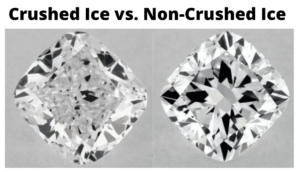
Pay attention to the center of the table, and you’ll notice the distinction.
Brilliant cut cushions maximize brilliance and fire. Strong light performance causes it to appear to have a larger diameter than other types.
Cushion modified hybrids are a modern cut that combines the facet patterns of the crushed ice and brilliant cushion cuts.
On the outside, star-shaped facets approach the girdle. In the middle, the crushed ice aesthetic is present.
There are pros and cons to each version of cushion cut diamonds, so explore each one to determine which fits your style.
Fit a Variety of Settings
Consider more than the center diamond when choosing an engagement ring.
The setting for your cushion cut adds a unique element to your ring and showcases your diamond in a variety of ways.
Cushion cuts fit many types of settings.
Keep all the attention on your diamond by selecting a solitaire setting with no embellishments on the ring.
Whether the shank is yellow or rose gold or platinum, it won’t compete with any diamond accents or milgrain lining the shank.
For example, this 14K white gold solitaire engagement ring from James Allen displays a cushion cut in a four-prong setting.
Notice how the four prongs reach over the crown but minimize how much of its facets are covered. This ensures maximum visibility of the diamond.
Many buyers add sparkle to their ring with a halo of smaller diamonds around the main one. A halo adds brilliance to the piece without a significant price increase.
It can also make the main diamond look larger.
This halo setting features a cushion cut with pave circling it, in addition to cascading down the shank.
You may decide on a cushion-shaped composite diamond, which features many small diamonds placed tightly together to form the illusion of a single diamond.
Explore how your cushion cut fits in several types of settings.
You may find the solitaire design most appealing or opt to complement it with more diamonds or other enhancements.
No Sharp Corners
Cushion cut diamonds don’t have sharp corners. The sharp edges on princess, marquise, and pear cuts leave them more vulnerable to chipping.
I’ve highlighted those qualities in this image.
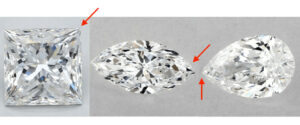
They’re one of the weakest areas of a diamond, so they should be protected with a strong setting.
Cushion cuts are more durable because of their rounded edges. If it’s dropped or hit, the corners are less likely to break compared to other cuts.
You should still take proactive steps to protect cushion cuts. For example, remove your ring during physical activity or instances where the setting could snag on clothing or furniture.
The girdle and table are still susceptible to breaking, so be mindful of when and how you wear cushion cuts.
Popular for Colored Diamonds
Cushion cuts have larger facets than some other diamonds, so they retain color.
In the case of the green, red, and orange cushion cuts below, you can tell their color runs deep.
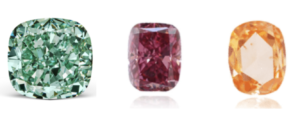
If you placed a cushion cut next to a round brilliant, and they both had the same color grade from the Gemological Institute of America (GIA), the round cut would likely appear more colorless.
This can be a downside of cushion cuts if you’re searching for a colorless diamond because you’ll have to pay a premium for a higher color grade.
But the lower cost per carat often outweighs it, so it’s still less expensive.
But for colored cushion cuts, this quality is a benefit.
Whether it’s green, red, orange, blue, or yellow, it’s a darker shade than what you would expect with a round or princess cut.
Cons of Cushion Cut Diamonds
Lacks Brilliance Compared to Round Cuts
The brilliance of any fancy shapes, including cushion, doesn’t compare to the brilliance of a round cut diamond.
Round cuts are designed for light performance by capturing and reflecting as much light as possible. It’s part of what makes them the most valuable cut on the market.
Cushion cuts still exhibit strong brilliance. In fact, its brilliance is comparable to radiant and princess cuts.
The large facets on a cushion cut are most conducive to giving off strong fire, but its white light performance shouldn’t be ignored.
Cushion cuts have more sparkle than Carre and Asscher cuts, in addition to other step-cut diamonds.
Doesn’t Hide Inclusions
Inclusions are imperfections in a diamond that diminish its appearance, durability, and brilliance.
Inclusions such as etch channels, twinning wisps, and feathers distort the way light is reflected and can be visible to the naked eye.
For example, the clarity characteristics plot on the GIA report below shows multiple needles and a cloud.
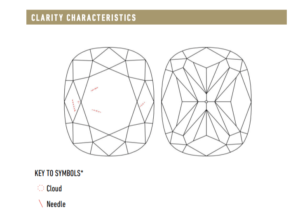
Most buyers aren’t concerned with finding a flawless diamond with no inclusions at 10x magnification.
Instead, they opt for an eye-clean diamond that looks flawless when viewed without magnification, like this cushion cut.
Some cuts hide inclusions better than others, and cushion cuts rank low in comparison to many others.
Round brilliant cuts hide inclusions with their strong brilliance, but the large facets on a cushion cut make them more visible.
In most cases, a cushion cut with an SI1 clarity grade from the GIA will appear eye-clean. If you choose a cushion cut heavier than two carats, consider a VS2 clarity grade.
Appears Smaller Than Other Fancy Shapes
The size of a diamond isn’t measured by its visible appearance, but many buyers want to find a diamond that looks larger than other cuts of the same weight.
Cushion cuts appear smaller to the naked eye compared to other fancy shapes, even if they’re the same carat weight.
It features a deep cut, which means much of its weight is under the surface.
Its surface area is more condensed compared to the elongated shape of a marquise, oval, or emerald cut diamond.
These diamonds are more shallow than cushion cuts.
Cushion cuts counter this downside by having a lower price per carat versus other cuts. You can increase its carat weight, and it can result in a similar cost as another cut with a slightly lower weight.
Not Given a GIA Cut Grade
The GIA doesn’t provide a cut grade for cushion cut diamonds. In fact, it won’t designate the quality of a cut for any fancy shape.
The GIA notes there isn’t an internationally accepted set of criteria for evaluating fancy cut diamonds.
A diamond’s cut is one of its most important aspects, so ensure your cushion cut has the traits that align with a quality cut.
For example, examine the GIA grading report and note its symmetry and polish.
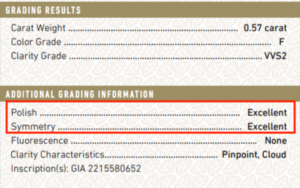
An excellent grade in both categories is often indicative of a quality cut, but always view the diamond in person or through a high-resolution image online.
You can’t always determine if it’s a poor, good, very good, or excellent cut from the grading report.
How to Decide if a Cushion Cut is Right for You
Cushion cuts have pros and cons you should explore in detail.
Here are some tips to help decide whether a cushion cut is right for you. Opt for a cushion cut if:
- You’re interested in a diamond with a lower cost per carat than round cuts
- Their high degree of brilliance and fire is appealing
- You want a diamond that lacks sharp corners, so it isn’t as vulnerable to chipping
If you land on a cushion cut, explore a variety of options with various carat weights, clarity grades, and colors.
You may find carat weight is more important to you than color and consider a larger cushion cut with a slight yellow tint.
Pair your cushion cut with different types of settings. A solitaire ring may fit your taste better than one with channel-set diamonds and a halo.
By comparing cushion cuts to other gems and combining it with the right setting, you’ll find a diamond ring that’s perfect for your style.

Jacob Clarke
Jacob Clarke is the founder of TeachJewelry.com.
He earned an Applied Jewelry Professional Diploma from the Gemological Institute of America (GIA) and now brings you essential information about diamonds, settings, and more.
Jacob has consulted with leading jewelry brands, and his work has been cited in Clean Origin, Diamond Nexus and industry publications.
He's also a member of the International Gem Society.
He enjoys discussing jewelry with readers, so contact him with any questions at jacob.clarke@teachjewelry.com.

